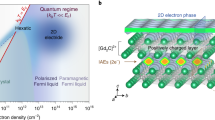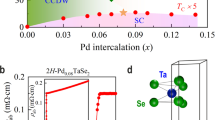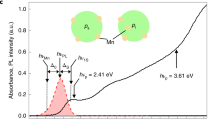Abstract
One of the defining properties of electrons is their mutual Coulomb repulsion. However, in solids this basic property may change; for example, in superconductors, the coupling of electrons to lattice vibrations makes the electrons attract one another, leading to the formation of bound pairs. Fifty years ago it was proposed1 that electrons can be made attractive even when all of the degrees of freedom in the solid are electronic, by exploiting their repulsion from other electrons. This attraction mechanism, termed ‘excitonic’, promised to achieve stronger and more exotic superconductivity2,3,4,5,6. Yet, despite an extensive search7, experimental evidence for excitonic attraction has yet to be found. Here we demonstrate this attraction by constructing, from the bottom up, the fundamental building block8 of the excitonic mechanism. Our experiments are based on quantum devices made from pristine carbon nanotubes, combined with cryogenic precision manipulation. Using this platform, we demonstrate that two electrons can be made to attract each other using an independent electronic system as the ‘glue’ that mediates attraction. Owing to its tunability, our system offers insights into the underlying physics, such as the dependence of the emergent attraction on the underlying repulsion, and the origin of the pairing energy. We also demonstrate transport signatures of excitonic pairing. This experimental demonstration of excitonic pairing paves the way for the design of exotic states of matter.
This is a preview of subscription content, access via your institution
Access options
Subscribe to this journal
Receive 51 print issues and online access
$199.00 per year
only $3.90 per issue
Buy this article
- Purchase on Springer Link
- Instant access to full article PDF
Prices may be subject to local taxes which are calculated during checkout




Similar content being viewed by others
References
Little, W. A. Possibility of synthesizing an organic superconductor. Phys. Rev. 134, A1416–A1424 (1964)
Ginzburg, V. L. Concerning surface superconductivity. Sov. Phys. JETP 20, 1549–1550 (1964)
Allender, D. & Bardeen, J. Model for an exciton mechanism of superconductivity. Phys. Rev. B 7, 1020–1029 (1973)
Ginzburg, V. L. High-temperature superconductivity—dream or reality? Sov. Phys. Usp. 19, 174–179 (1976)
Hirsch, J. E. & Scalapino, D. J. Excitonic mechanism for superconductivity in a quasi-one-dimensional system. Phys. Rev. B 32, 117–134 (1985)
Micnas, R., Ranninger, J. & Robaszkiewicz, S. Superconductivity in narrow-band systems with local nonretarded attractive interactions. Rev. Mod. Phys. 62, 113–171 (1990)
Jérome, D. in The Physics of Organic Superconductors and Conductors (ed. Lebed, A. ) 3–16 (Springer, 2008)
Raikh, M. E., Glazman, L. I. & Zhukov, L. E. Two-electron state in a disordered 2D island: pairing caused by the coulomb repulsion. Phys. Rev. Lett. 77, 1354–1357 (1996)
Bardeen, J., Cooper, L. & Schrieffer, J. Microscopic theory of superconductivity. Phys. Rev. 106, 162–164 (1957)
Hirsch, J. E. & Scalapino, D. J. Double-valence-fluctuating molecules and superconductivity. Phys. Rev. B 32, 5639–5643 (1985)
Varma, C. Missing valence states, diamagnetic insulators, and superconductors. Phys. Rev. Lett. 61, 2713–2716 (1988)
Matsushita, Y., Bluhm, H., Geballe, T. H. & Fisher, I. R. Evidence for charge Kondo effect in superconducting Tl-doped PbTe. Phys. Rev. Lett. 94, 157002 (2005)
Butler, M. R., Movaghar, B., Marks, T. J. & Ratner, M. A. Electron pairing in designer materials: a novel strategy for a negative effective Hubbard U. Nano Lett. 15, 1597–1602 (2015)
Oganesyan, V., Kivelson, S., Geballe, T. & Moyzhes, B. Josephson tunneling spectroscopy of negative-U centers. Phys. Rev. B 65, 172504 (2002)
Hirsch, J. E., Tang, S., Loh, E. Jr & Scalapino, D. J. Pairing interaction in two-dimensional CuO2 . Phys. Rev. Lett. 60, 1668–1671 (1988)
Ge, J. et al. Superconductivity above 100 K in single-layer FeSe films on doped SrTiO3 . Nat. Mater. 14, 285–289 (2015)
Richter, C. et al. Interface superconductor with gap behaviour like a high-temperature superconductor. Nature 502, 528–531 (2013)
Cheng, G. et al. Electron pairing without superconductivity. Nature 521, 196–199 (2015)
Firstenberg, O. et al. Attractive photons in a quantum nonlinear medium. Nature 502, 71–75 (2013)
Waissman, J. et al. Realization of pristine and locally tunable one-dimensional electron systems in carbon nanotubes. Nat. Nanotechnol. 8, 569–574 (2013)
Averin, D. V. & Bruder, C. Variable electrostatic transformer: controllable coupling of two charge qubits. Phys. Rev. Lett. 91, 057003 (2003)
Lobos, A. M., Iucci, A., Müller, M. & Giamarchi, T. Dissipation-driven phase transitions in superconducting wires. Phys. Rev. B 80, 214515 (2009)
Goldstein, M., Berkovits, R. & Gefen, Y. Population switching and charge sensing in quantum dots: a case for a quantum phase transition. Phys. Rev. Lett. 104, 226805 (2010)
Yoo, G., Park, J., Lee, S.-S. B. & Sim, H.-S. Anisotropic charge Kondo effect in a triple quantum dot. Phys. Rev. Lett. 113, 236601 (2014)
Medford, J. et al. Quantum-dot-based resonant exchange qubit. Phys. Rev. Lett. 111, 050501 (2013)
Braakman, F., Barthelemy, P., Reichl, C., Wegscheider, W. & Vandersypen, L. M. K. Long-distance coherent coupling in a quantum dot array. Nat. Nanotechnol. 8, 432–437 (2013)
Seo, M. et al. Charge frustration in a triangular triple quantum dot. Phys. Rev. Lett. 110, 046803 (2013)
Delbecq, M. R. et al. Full control of quadruple quantum dot circuit charge states in the single electron regime. Appl. Phys. Lett. 104, 183111 (2014)
Fölsch, S., Martínez-Blanco, J., Yang, J., Kanisawa, K. & Erwin, S. C. Quantum dots with single-atom precision. Nat. Nanotechnol. 9, 505–508 (2014)
Acknowledgements
We thank E. Altman, E. Berg, Y. Gefen, M. Goldstein, U. Leonhardt, G. Refael and A. Yacoby for discussions and D. Mahalu for the e-beam writing. K.K. acknowledges support from the Carlsberg Foundation. Y.O. acknowledges support by Minerva, BSF and ERC Adg grant (FP7/2007-2013 340210). F.v.O. acknowledges support through SPP 1459 and SFB 658. S.I. acknowledges financial support by the ERC Cog grant (See-1D-Qmatter, No. 647413).
Reviewer Information Nature thanks R. Egger, T. Kontos and E. Scheer for their contribution to the peer review of this work.
Author information
Authors and Affiliations
Contributions
A.H., A.B., I.S. and S.I. performed the experiments, analysed the data, contributed to its theoretical interpretation and wrote the paper. I.S. built the scanning probe microscope. I.K. built the custom measurement instrumentation for the experiment. J.W. designed and fabricated the devices. K.K., Y.O. and F.v.O. developed the theoretical model. K.K. performed the theoretical simulations.
Corresponding author
Ethics declarations
Competing interests
The authors declare no competing financial interests.
Supplementary information
Supplementary Information
This file contains Supplementary Text and Data, which includes Supplementary Methods, Supplementary Figures 1-10, a Supplementary Discussion and additional references. (PDF 2798 kb)
Rights and permissions
About this article
Cite this article
Hamo, A., Benyamini, A., Shapir, I. et al. Electron attraction mediated by Coulomb repulsion. Nature 535, 395–400 (2016). https://doi.org/10.1038/nature18639
Received:
Accepted:
Published:
Issue Date:
DOI: https://doi.org/10.1038/nature18639
This article is cited by
-
Development of a macroinvertebrate-based biotic index to assess water quality of rivers in Niger State, North Central Ecoregion of Nigeria
Environmental Monitoring and Assessment (2024)
-
Probing resonating valence bonds on a programmable germanium quantum simulator
npj Quantum Information (2023)
-
Quasiperiodic circuit quantum electrodynamics
npj Quantum Information (2023)
-
Cooling and self-oscillation in a nanotube electromechanical resonator
Nature Physics (2020)
-
Possible Superconductivity in the Brain
Journal of Superconductivity and Novel Magnetism (2019)
Comments
By submitting a comment you agree to abide by our Terms and Community Guidelines. If you find something abusive or that does not comply with our terms or guidelines please flag it as inappropriate.



